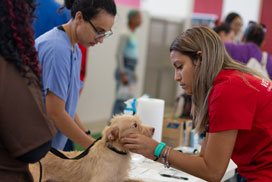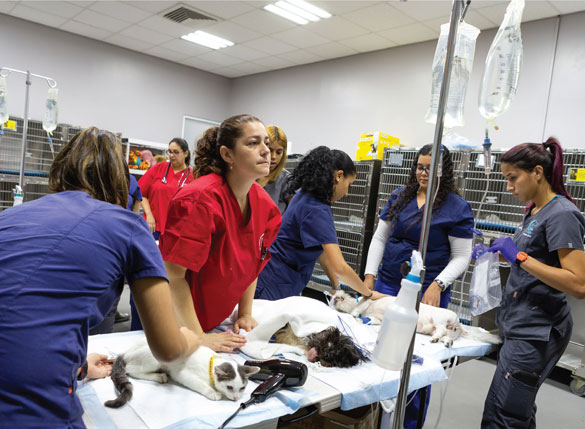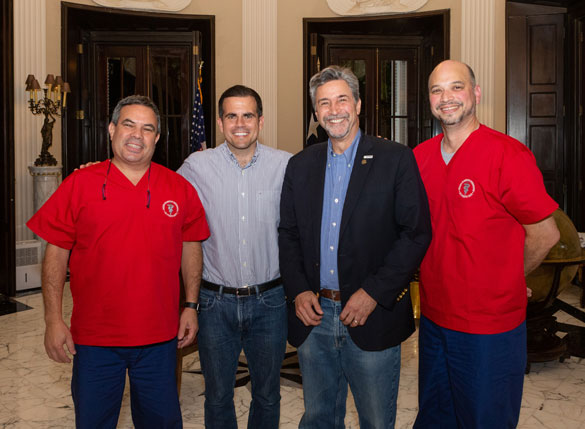In Puerto Rico, time measured before and after Maria
People and their pets fill the lobby waiting their turn to be called into a back area. There, teams of veterinarians and veterinary technicians studiously probe and examine the nervous cats and dogs. They then take the animals to another room where they are sedated and prepped for surgery by one of five veterinarians operating in assembly line–like fashion. Almost as soon as one patient is sutured and sent to recovery, another is placed on the quickly sanitized table.


It is only the second day of the weeklong Spayathon for Puerto Rico. The high-quality, high-volume spay-neuter initiative was held for the first time in June 2018 after Hurricane Maria, one of the worst natural disasters in the island's history, made the U.S. commonwealth's stray animal problem even worse.
See the Photo Gallery

This second spayathon is being held in early November 2018. Although it is not yet 9 a.m., which is when the doors open at the Animal Control Center in the municipality of Carolina, people already gather outside with their pets despite the rain. Located roughly 14 miles east of the San Juan capital, the center is one of several spayathon venues across the island. By week's end, veterinary professionals at all locations will have collectively castrated, vaccinated, and microchipped thousands of cats and dogs free of charge. AVMA President John de Jong, who grew up in Puerto Rico, was among the many veterinarians volunteering their services during the week.
Those left behind
Each spayathon location is managed and staffed by a small army of volunteers from veterinary and animal welfare organizations on the island and in the states. Dr. Frances Piñero is president-elect of the Puerto Rico VMA, which is staffing the Animal Control Center during the weeklong event. Dr. Piñero said no aspect of Puerto Rico went untouched by the Category 4 hurricane when it made landfall in September 2017. The impact on the island's animal population was especially severe.
"Honestly, it was just pure devastation," she said. "We have all these stray animals before Maria, and then we have all these other animals left by their owners. Many did take their animals with them, but many others did not."
As Puerto Rico continues to recover from one of the most devastating natural disasters in the island's history, veterinarians there are experiencing a new urgency to address the pet overpopulation problem and educate the public about responsible pet ownership.
The elective part of the profession was put on hold. We were dealing with only emergency cases and cases that required immediate attention.
Dr. Carlos Mongil
Dr. Angel Ramos, a practice owner in the mountain town of Jayuya who volunteered at the center, recalled a surreal moment following the hurricane that, for him, underscored the seriousness of the problem. "Puerto Rico has always had an issue with strays, but you don't expect to see a purebred dog walking down the road. So, when you see a Great Dane coming along the road, you're wondering what's going on," Dr. Ramos said.
Just how many pets were abandoned in Puerto Rico because of Maria is not known. Shortly after the hurricane, Puerto Rico Gov. Ricardo Rosselló signed an executive order authorizing the Humane Society of the United States and Humane Society International to assist animal-focused disaster relief work in the commonwealth. Ultimately, a memorandum of understanding was struck among the Puerto Rican government, HSUS, PRVMA, and Puerto Rico Board of Veterinary Medical Examiners to implement Spayathon for Puerto Rico with a goal of spaying and neutering more than 21,000 animals within an 18-month period.
Veterinary services

All things considered, Puerto Rico's veterinary community weathered Maria relatively well. No veterinarian is reported to have been among the nearly 3,000 deaths attributed to the hurricane. Most practices were up and running within a few days, albeit without power. Dr. Ramos' Jayuya practice had no electricity until mid-December 2017.
"That was one of the roughest things, in terms of trying to provide the same type of service without being able to turn on my equipment," he said. "I had to move out everything from the refrigerator—tests, vaccines, medications—to a small cooler and add ice and ice packs to keep products in correct temperature. After a few days, a neighbor with a generator offered to give us an extension cord so we could run the refrigerator and microscope."
"Even with no electricity, I opened the clinic because people were coming to my house with sick pets," Dr. Ramos continued. "I would do as much as I could but ended up opening with limited hours and services so I could at least see patients that needed medical attention. I still did surgeries using a combination of IV and gas anesthesia, but it was very difficult to maintain a clean environment; it was very hot, so windows had to be opened, and we had no running water."
The specialty practice in San Juan where Dr. Carlos Mongil is a small animal surgeon ran on a generator for three months. "Getting fuel was a huge ordeal," he said. "We had to reduce our working hours so we had enough fuel for the following day. Our work days were cut short as there was a curfew and everyone had to be home by 7 p.m."

"Communications were horrible," Dr. Mongil continued. "It was really hard to communicate not only with pet owners but also with referring veterinarians about cases referred for surgery. Clients would just show up at the door without appointments, and neither the owners nor the referring veterinarians were able to communicate with us to coordinate the referral. The referring veterinarians would often come and bring us radiographs and consults as they were not able to reach us by phone."

In the immediate aftermath of Maria, veterinary services in Puerto Rico entered a triage phase. "There were a lot more trauma cases," Dr. Mongil explained. "The elective part of the profession was put on hold. We were dealing with only emergency cases and cases that required immediate attention."
Given the large numbers of stray animals, standing water, and unsanitary conditions, the veterinary community quickly grew concerned about the likelihood of outbreaks of leptospirosis and rabies. Veterinarians fanned out across the island, vaccinating thousands of animals at no charge. Dozens of people are suspected of having contracted leptospirosis, and at least two deaths are confirmed to have been linked to the bacterial infection.
Responsible pet ownership
More than a year since Maria, things at Dr. Mongil's practice are nearly back to normal. "Our case distribution has gone back to being what it used to be, in terms of the proportion of emergencies and critical care procedures and elective procedures," he said. "We're mostly back to where we were before the hurricane, but Maria did change the entire island. Everything is before Maria and after Maria."
Dr. Ramos doesn't judge the people who fled Maria without their pets. He understands that when confronted by life-or-death situations, people instinctively think about their own survival. He suspects that many Puerto Ricans, especially in rural areas, thought Maria wasn't going to be as bad as it was. In early September 2017, Hurricane Irma "grazed" Puerto Rico after the storm was predicted to be much worse.

"A lot of people thought the same about Maria. It wasn't until, like, two days before that we realized we were going to get hit. That's when everybody started to panic," Dr. Ramos said.
Puerto Rico has always had an issue with strays, but you don't expect to see a purebred dog walking down the road.
Dr. Angel Ramos
Many Puerto Rican veterinarians believe the island's stray animal problem is symptomatic of a general lack of understanding about responsible pet ownership. The attitude toward animals in Puerto Rico differs from that in the states, Dr. Ramos said. "I've worked in both places, and you can see that people here have a bit more of a learning curve to go in terms of the value of veterinary medicine."
Dr. Mongil believes sterilization is a small part of the overall solution. "Education is the No. 1 thing that we need to work on," he observed. "People need to be educated so that we can change the way they think about their pets. Things here have gotten a lot better in the last 20 years, but there's still a lot of work that needs to be done regarding what a responsible owner should do for their pets."
Dr. Piñero, the PRVMA president-elect, wants the association to step up its outreach to the public and most especially children. "If we don't educate these young people, how are we going to be able to improve? We need to start at the beginning," she said. "Obviously, we try to educate everybody, but our focus should be on those youngsters who are the future of Puerto Rico."


Check out the video to learn more about Spayathon for Puerto Rico and the island's welfare issues.
Related JAVMA content:
Slow recovery after Hurricane Maria (Feb. 1, 2018)
Devastation in Puerto Rico (Nov. 15, 2017)